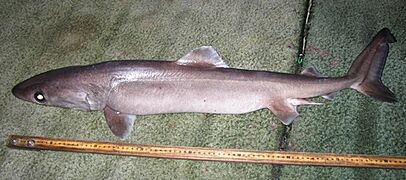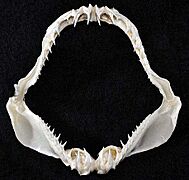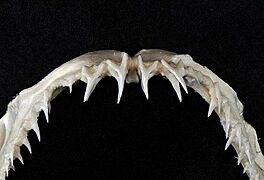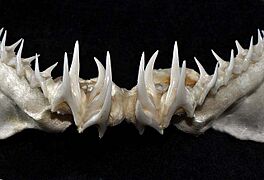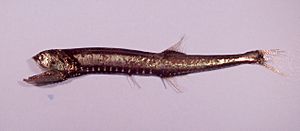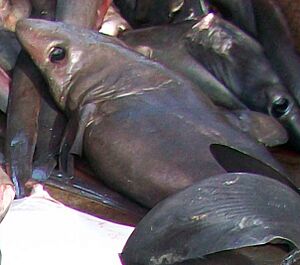Crocodile shark facts for kids
Quick facts for kids Crocodile shark |
|
|---|---|
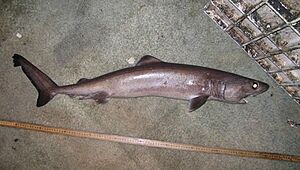 |
|
| Conservation status | |
| Scientific classification | |
| Genus: |
Pseudocarcharias
|
| Species: |
kamoharai
|
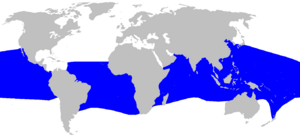 |
|
| Range of the crocodile shark | |
| Synonyms | |
|
Carcharias kamoharai Matsubara, 1936 |
|
The crocodile shark (Pseudocarcharias kamoharai) is a fascinating type of mackerel shark. It is the only living member of its family, Pseudocarchariidae. This shark lives in the deep, open ocean, in warm waters around the world. You can find it from the surface down to about 590 meters (1,935 feet) deep.
Crocodile sharks are known for their daily vertical migration. They stay deep, below 200 meters (656 feet), during the day. At night, they swim up to shallower waters to hunt for food. These sharks are quite small for a mackerel shark, usually growing to about 1 meter (3.3 feet) long. You can spot them by their long, cigar-shaped bodies, very large eyes, and small fins.
This shark is an active predator, meaning it hunts other animals. It eats bony fishes, squid, and shrimp. The crocodile shark has a large, oily liver. This helps it float easily in the water without using much energy. Its big eyes suggest it hunts mostly at night. Female crocodile sharks usually give birth to four pups. The baby sharks eat undeveloped eggs inside their mother before they are born. Because of its small size, the crocodile shark is not dangerous to humans. It is also not very important for commercial fishing. Interestingly, in 1985, these sharks caused damage to new deep-sea fiber optic cables.
Contents
What is a Crocodile Shark?
The name "crocodile shark" comes from its Japanese name, "mizuwani." This means "water crocodile." The name refers to its sharp teeth and how it snaps when caught. Other names for this shark include Japanese ragged-tooth shark and Kamohara's sand-shark.
The crocodile shark was first described in 1936. A scientist named Kiyomatsu Matsubara wrote about it. He based his description on a shark found in Japan. Later, in 1973, another scientist, Leonard Compagno, gave it its own family. This was because of its unique features.
Scientists have studied the crocodile shark's body and DNA. They think it might be related to other sharks like the megamouth shark or sand sharks. Fossils of crocodile shark teeth have been found in Italy. These fossils are about 11.6 to 13.6 million years old. They look just like the teeth of today's crocodile sharks.
Appearance of the Crocodile Shark
The crocodile shark has a body shaped like a spindle, which is wide in the middle and tapers at both ends. It has a short head and a pointed snout. Its eyes are very large and do not have a third eyelid. The five pairs of gill slits are long.
Its large mouth can stick out almost to the tip of its snout. It has big teeth, which are spiky in the front and knife-like on the sides. There are fewer than 30 rows of teeth in each jaw.
The shark's fins are relatively small. The pectoral fins are broad and rounded. The pelvic fins are almost as big as the pectoral fins. It has two dorsal fins; the first is larger than the second. The anal fin is smaller than the second dorsal fin. The tail fin is uneven, with a longer upper part.
The crocodile shark is dark brown on top and lighter underneath. Sometimes it has dark spots on its sides and belly. It might also have a white spot near its mouth. The edges of its fins are thin and clear or white. This shark can grow up to 1.1 meters (3.6 feet) long. Most adults are about 1 meter (3.3 feet) long and weigh 4 to 6 kilograms (9 to 13 pounds).
Where Crocodile Sharks Live
Crocodile sharks live in tropical waters all around the world. In the Atlantic Ocean, they are found near Brazil, South Africa, and other places. In the Indian Ocean, they live in areas like the Mozambique Channel. In the Pacific Ocean, they are found from Japan down to Australia and New Zealand. They also live along the western coasts of the Americas.
This shark prefers waters where the average sea surface temperature is about 20°C (68°F). They are not found everywhere but are common in certain spots. This suggests they do not travel very far. Crocodile sharks usually live in the open ocean, from the surface down to 590 meters (1,935 feet). Sometimes, they are seen closer to shore near the bottom. In 2017, a crocodile shark washed ashore in England. This was unusual, as it was far north of its normal range.
Life and Habits
The crocodile shark has a long body and small fins. It also has a large liver full of oil. This helps it float easily in the water. Its liver can make up about one-fifth of its body weight. This allows it to stay at a certain depth without much effort.
Like many deep-sea animals, the crocodile shark moves up and down each day. It comes closer to the surface at night to feed. During the day, it goes back down into deeper water, usually below 200 meters (656 feet).
The shark's large eyes have a special reflective layer. This helps it see in the dark. It suggests the crocodile shark is a nocturnal hunter. It likely uses its sight to find prey by their shapes or bioluminescence (light they produce). Not much is known about what they eat exactly. However, they are thought to be fast, active predators. Their diet includes small to medium-sized bony fishes, squid, and shrimp. No other animals are known to hunt crocodile sharks.
Crocodile sharks give birth to live young. Females usually have four pups, two in each uterus. The baby sharks develop inside the mother. Once their yolk sacs are used up, they start eating undeveloped eggs. The mother produces these eggs just for the embryos to eat. The bellies of the baby sharks become very full from eating these eggs. Pups are born at about 40 centimeters (16 inches) long. Males become mature when they are 74 to 110 centimeters (29 to 43 inches) long. Females mature at 89 to 102 centimeters (35 to 40 inches) long. They do not have a specific breeding season.
Crocodile Sharks and Humans
Crocodile sharks are small and live in the open ocean. They are not considered dangerous to humans. However, they can bite powerfully, so caution is advised. This species is often caught by accident in fishing nets. These nets are usually set for tuna and swordfish. Many are caught by Japanese and Australian fishing boats in the Indian Ocean.
Fishermen usually throw crocodile sharks back into the ocean. This is because they are small and their meat is not considered high quality. However, their oily livers might be valuable. We do not have much information on how many crocodile sharks there are. But their numbers are probably going down because of accidental catches. Also, they do not have many babies. Because of this, the International Union for Conservation of Nature (IUCN) lists them as "Near Threatened."
In 1985, AT&T put in the first deep-sea fiber optic cables. These cables connected islands in the Canary Islands. Soon after, the system had problems with shorts. It was found that crocodile sharks were biting the cables. They might have been attracted to the electric field around the cables. Since these sharks do not usually live on the ocean floor, they were likely biting the cables as they were being put in. The problem was solved by adding a layer of steel tape and a thick plastic coating to the cables.



